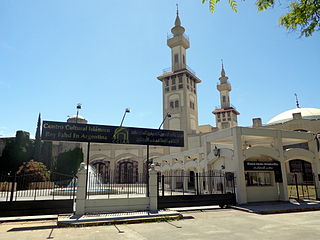
Chile's 2017 census reported a population of 17,574,003 people. Its rate of population growth has been decreasing since 1990, due to a declining birth rate. By 2050 the population is expected to reach approximately 20.2 million people, at which point it is projected to either stagnate or begin declining. About 85% of the country's population lives in urban areas, with 40% living in Greater Santiago alone. The largest agglomerations according to the 2002 census are Greater Santiago with 5.6 million people, Greater Concepción with 861,000 and Greater Valparaíso with 824,000.

Asian Argentines, are Argentine citizens or residents of Asian ancestry. The vast majority trace their ancestry to West Asia, primarily from Lebanon, Syria and Armenia, and the Far East, primarily from China and Japan. However, there are other communities of Indian origin as well. Asian Argentines settled in Argentina in large numbers during several waves of immigration in the 20th century.

The history of immigration to Argentina can be divided into several major stages:

Argentina has a racially and ethnically diverse population. The territory of what today is Argentina was first inhabited by numerous indigenous peoples. The first white settlers came during the period of Spanish colonization, beginning in the 16th century. The Spaniards imported African slaves, who would go on to become the first Afro-Argentines. Following independence from Spain in the 19th century and well into the 20th century, numerous migration waves took place, with Argentina being the second most popular destination for migrants in the early 20th century, after the United States. Most of these migrants came from Europe.
Immigration to Chile has contributed to the demographics and the history of this South American nation. Chile is a country whose inhabitants are mainly of Iberian, mostly of Andalusian and Basque origin, and Native American, mostly descended from Mapuche peoples. A moderate numbers of European immigrants settled in Chile during the 19th and 20th centuries, mainly Spanish, as well as Germans, British, French, Southern Slavs, and Italians who have made additional contributions to the racial complex of Chile. However, this immigration was never in a large scale, contrasting with mass migrations that characterized Argentina, Uruguay and southern Brazil, and therefore, anthropologically, its impact with lesser consequence. At the same time, some separate cultural aspects, such as German cakes, British afternoon tea, and Italian pasta, were preserved. The fusion is also visible in the architecture of Chilean cities. This intermarriage and mixture of cultures and races have shaped the present society and culture of Chile.
Koreans in Chile formed Latin America's sixth-largest Korean diaspora community as of 2011, according to the statistics of South Korea's Ministry of Foreign Affairs and Trade.

Argentines, Argentinians or Argentineans are people from Argentina. This connection may be residential, legal, historical, or cultural. For most Argentines, several of these connections exist and are collectively the source of their being Argentine.
Illegal immigration in Chile is a phenomenon that largely began in the 1990s as a result of economic growth and political stability in Chile. Most immigrants are South American, with the largest wave being Peruvian, although there has also been a significant amount of migration from the Caribbean. Illegal immigration is primarily caused by a lack of security or economic opportunities in the country of origin.

Spaniards in France are people from Spain residing in France and their descendants. They may be French citizens or non-citizen immigrants or expatriates.

Immigration to Uruguay began in several millennia BCE with the arrival of different populations from Asia to the Americas through Beringia, according to the most accepted theories, and were slowly populating the Americas. The most recent waves of immigrants started with the arrival of Spaniards in the 16th century, during the colonial period, to what was then known as the Banda Oriental.
Argentine Jews in Israel are immigrants and descendants of the immigrants of the Argentine Jewish community who now reside within the state of Israel. Argentine Jewish immigration to Israel has been, and still is, the largest and most significant migratory flow from South America. This is because Argentina has one of the largest Jewish communities in the world, the third largest in the Americas after those in the United States and Canada, and seventh worldwide. Because of this, many Jewish Argentines are able to make aliyah and become Israeli citizens through the Law of Return. The Argentine community in Israel is about 50,000 people, although some estimates put the figure at 70,000, making it one of the fastest-growing groups in the country.

Historically, the migratory history of Paraguay has been ambiguous, since it has had periods of large scale emigration as well as large waves of immigrants, primarily from Europe.

The Santiago International Book Fair is an annual book fair held in Santiago, Chile, during October–December. It is organised by the Chilean Chamber for Books.
Javier Enrique Cárdenas Escalona, better known as Javicoro, is a Venezuelan YouTuber, blogger, reporter, podcaster and activist for the rights of immigrants, goodwill Ambassador for International Organization for Migration (IOM). and member of the Non-profit Civil Association. "Alliance for Venezuela"

Diplomatic relations between the Argentine Republic and the Bolivarian Republic of Venezuela have existed for decades.

Venezuelan Argentines are Argentine citizens of predominantly or total Venezuelan descent, or Venezuelan citizens who have migrated to and settled in Argentina. As of 2022, there are 272,000 Venezuelans living in Argentina, most of whom migrated during the latter half of the 2010s as part of the Venezuelan refugee crisis. The last census held in Argentina, in 2010, registered only 6,000 Venezuelan migrants living in the country.

The National Directorate for Migration is a decentralised agency of the Government of Argentina responding to the Secretariat of the Interior which is responsible for handling the country's migration policies.
Latin Americans in Spain are individuals in Spain who are from or descend from individuals from Latin America. As of January 2021, there are 2,480,373 South Americans in Spain, and 624,034 Central American or Caribbean people in Spain. Flows of migration have been dependent on the economic conditions in their countries of birth and in Spain. Colombians in Spain constitute the largest group of Latin Americans in the country.

Peruvian Argentines are Argentine citizens of partial or full peruvians descent, or Peruvian citizens who have migrated to and settled in Argentina.

White Chileans are Chileans who have predominantly or total European or West Asian ancestry, these stand out for having light or olive skin. White Chileans are currently the largest group in Chile.





















